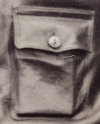It appears that the 1931 US Government fiscal year was July 1, 1930 - June 30, 1931. That may or may not be relevant or helpful to this discussion.
Yes, those 1931 financial year dates can be of help.
Looking at an A-1 label the order number is 31-800P, suggesting an August-ish 1930 order date and the Goldsmith A-2 order number is 31-1897, suggesting an October-ish 1930 order date. The dates aren’t exact, but it does point to the A-1 replacement being completed during the fall of 1930 as noted by the Hell-Bent for Leather book by Nelson & Parsons. There were complaints noted at the time about the poor material quality of the A-1 knit cuffs and collar, so people may have purchased their own jacket instead of using an A-1. I did read an interesting article in one of the aircraft magazines from the time and they noted mail carriers were having a much greater life expectancy since they started wearing better garments – that would make me bundle up too.

